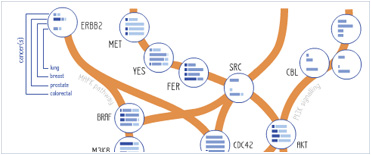NCOA62 Polyclonal Antibody
Purified Rabbit Polyclonal Antibody (Pab)
- SPECIFICATION
- CITATIONS
- PROTOCOLS
- BACKGROUND

Application
| IHC-P, IHC-F, IF, ICC, E |
|---|---|
| Primary Accession | Q13573 |
| Reactivity | Rat, Pig, Bovine |
| Host | Rabbit |
| Clonality | Polyclonal |
| Calculated MW | 61 KDa |
| Physical State | Liquid |
| Immunogen | KLH conjugated synthetic peptide derived from human NCOA62 |
| Epitope Specificity | 51-150/536 |
| Isotype | IgG |
| Purity | affinity purified by Protein A |
| Buffer | 0.01M TBS (pH7.4) with 1% BSA, 0.02% Proclin300 and 50% Glycerol. |
| SUBCELLULAR LOCATION | Nuclear |
| SIMILARITY | Belongs to the SNW family. |
| SUBUNIT | Interacts SKI, SMAD2,SMAD3, RBPJ, RB1, PABPN1, MAGEA1, SIRT1, FOXN3, U2AF2, PPIL1, DAXX and ATP1B4. Interacts with VDR and RXRA; preferentially associates with VDR:RXRA heterodimers. Interacts with NCOR2 and EBV EBNA2; NCOR2 and EBV EBNA2 compete for interaction with SNW1. Interacts with MAML1. Interacts with NOTCH1 NICD; the interaction involves multimerized NOTCH1 NICD. Forms a complex with NOTCH1 NICD and MAML1; the association is dissociated by RBPJ. Identified in the spliceosome C complex. Associates with U4/U6-U5 tri-small nuclear ribonucleoproteins (U4/U6-U5 tri-snRNPs). Associates with positive transcription elongation factor b (P-TEFb). Component of the SNARP complex which consists at least of SNIP1, SNW1, THRAP3, BCLAF1 and PNN. Interacts with human papillomavirus type-16 (HPV16) E7 protein. |
| Important Note | This product as supplied is intended for research use only, not for use in human, therapeutic or diagnostic applications. |
| Background Descriptions | This gene, a member of the SNW gene family, encodes a coactivator that enhances transcription from some Pol II promoters. This coactivator can bind to the ligand-binding domain of the vitamin D receptor and to retinoid receptors to enhance vitamin D-, retinoic acid-, estrogen-, and glucocorticoid-mediated gene expression. It can also function as a splicing factor by interacting with poly(A)-binding protein 2 to directly control the expression of muscle-specific genes at the transcriptional level. Finally, the protein may be involved in oncogenesis since it interacts with a region of SKI oncoproteins that is required for transforming activity. [provided by RefSeq, Jul 2008] |
| Gene ID | 22938 |
|---|---|
| Other Names | SNW domain-containing protein 1, Nuclear protein SkiP, Nuclear receptor coactivator NCoA-62, Ski-interacting protein, SNW1 |
| Dilution | IHC-P=1:100-500,IHC-F=1:100-500,ICC=1:100-500,IF=1:100-500,ELISA=1:5000-10000 |
| Storage | Store at -20 ℃ for one year. Avoid repeated freeze/thaw cycles. When reconstituted in sterile pH 7.4 0.01M PBS or diluent of antibody the antibody is stable for at least two weeks at 2-4 ℃. |
| Name | SNW1 |
|---|---|
| Function | Involved in pre-mRNA splicing as component of the spliceosome (PubMed:11991638, PubMed:28076346, PubMed:28502770). As a component of the minor spliceosome, involved in the splicing of U12-type introns in pre-mRNAs (Probable). Required for the specific splicing of CDKN1A pre- mRNA; the function probably involves the recruitment of U2AF2 to the mRNA. May recruit PPIL1 to the spliceosome. May be involved in cyclin- D1/CCND1 mRNA stability through the SNARP complex which associates with both the 3'end of the CCND1 gene and its mRNA. Involved in transcriptional regulation. Modulates TGF-beta-mediated transcription via association with SMAD proteins, MYOD1-mediated transcription via association with PABPN1, RB1-mediated transcriptional repression, and retinoid-X receptor (RXR)- and vitamin D receptor (VDR)-dependent gene transcription in a cell line-specific manner probably involving coactivators NCOA1 and GRIP1. Is involved in NOTCH1-mediated transcriptional activation. Binds to multimerized forms of Notch intracellular domain (NICD) and is proposed to recruit transcriptional coactivators such as MAML1 to form an intermediate preactivation complex which associates with DNA-bound CBF-1/RBPJ to form a transcriptional activation complex by releasing SNW1 and redundant NOTCH1 NICD. |
| Cellular Location | Nucleus |

Thousands of laboratories across the world have published research that depended on the performance of antibodies from Abcepta to advance their research. Check out links to articles that cite our products in major peer-reviewed journals, organized by research category.
info@abcepta.com, and receive a free "I Love Antibodies" mug.
Provided below are standard protocols that you may find useful for product applications.
If you have used an Abcepta product and would like to share how it has performed, please click on the "Submit Review" button and provide the requested information. Our staff will examine and post your review and contact you if needed.
If you have any additional inquiries please email technical services at tech@abcepta.com.













 Foundational characteristics of cancer include proliferation, angiogenesis, migration, evasion of apoptosis, and cellular immortality. Find key markers for these cellular processes and antibodies to detect them.
Foundational characteristics of cancer include proliferation, angiogenesis, migration, evasion of apoptosis, and cellular immortality. Find key markers for these cellular processes and antibodies to detect them. The SUMOplot™ Analysis Program predicts and scores sumoylation sites in your protein. SUMOylation is a post-translational modification involved in various cellular processes, such as nuclear-cytosolic transport, transcriptional regulation, apoptosis, protein stability, response to stress, and progression through the cell cycle.
The SUMOplot™ Analysis Program predicts and scores sumoylation sites in your protein. SUMOylation is a post-translational modification involved in various cellular processes, such as nuclear-cytosolic transport, transcriptional regulation, apoptosis, protein stability, response to stress, and progression through the cell cycle. The Autophagy Receptor Motif Plotter predicts and scores autophagy receptor binding sites in your protein. Identifying proteins connected to this pathway is critical to understanding the role of autophagy in physiological as well as pathological processes such as development, differentiation, neurodegenerative diseases, stress, infection, and cancer.
The Autophagy Receptor Motif Plotter predicts and scores autophagy receptor binding sites in your protein. Identifying proteins connected to this pathway is critical to understanding the role of autophagy in physiological as well as pathological processes such as development, differentiation, neurodegenerative diseases, stress, infection, and cancer.

